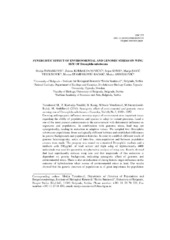Приказ основних података о документу
Synergistic effect of environmental and genomic stress on wing size of drosophila subobscura
| dc.creator | Tanasković, Marija | |
| dc.creator | Kurbalija Novičić, Zorana | |
| dc.creator | Kenig, Bojan | |
| dc.creator | Veselinović Savić, Marija | |
| dc.creator | Stamenković-Radak, Marina | |
| dc.creator | Anđelković, Marko | |
| dc.date.accessioned | 2017-11-23T11:26:55Z | |
| dc.date.available | 2017-11-23T11:26:55Z | |
| dc.date.issued | 2016 | |
| dc.identifier.issn | 0534-0012 | |
| dc.identifier.uri | http://www.doiserbia.nb.rs/Article.aspx?ID=0534-00121603039T | |
| dc.identifier.uri | https://radar.ibiss.bg.ac.rs/handle/123456789/2604 | |
| dc.description.abstract | Growing anthropogenic influence on every aspect of environment arise important issues regarding the ability of populations and species to adapt to variant pressures. Lead is one of the most present contaminants in the environment with detrimental influence on organisms and populations. In combination with genomic stress, lead may act synergistically, leading to reduction in adaptive values. We sampled two Drosophila subobscura populations, from ecologically different habitats and established differences in genetic backgrounds and population histories. In order to establish different levels of genome heterozygosity, series of intra-line, intra-population and between population crosses were made. The progeny was reared on a standard Drosophila medium and a medium with 200μg/mL of lead acetate and right wing of approximately 4000 individuals was used for geometric morphometric analysis of wing size. Results showed that lead significantly reduces wing size and that magnitude of this reduction is dependent on genetic background, indicating synergistic effect of genomic and environmental stress. There is also an indication of strong female origin influence on the outcome of hybridization when source of environmental stress is lead. Our results showed that the genetic structure of populations is of great importance for population fitness in anthropogenic induced stressful conditions. Further studies of synergistic effect of genetic and environmental stress are needed, as well as studies of its outcome in natural populations. | en |
| dc.relation | info:eu-repo/grantAgreement/MESTD/Basic Research (BR or ON)/173012/RS// | |
| dc.rights | openAccess | |
| dc.rights.uri | https://creativecommons.org/licenses/by-nc-nd/4.0/ | |
| dc.source | Genetika | |
| dc.subject | Keywords: Drosophila subobscura | |
| dc.subject | Hybridization | |
| dc.subject | Lead pollution | |
| dc.subject | Synergistic effect | |
| dc.subject | Wing size | |
| dc.title | Synergistic effect of environmental and genomic stress on wing size of drosophila subobscura | en |
| dc.type | article | |
| dc.rights.license | BY-NC-ND | |
| dcterms.abstract | Стаменковић-Радак, Марина; Aнђелковић, Марко; Курбалија-Новичић, Зорана; Танасковић, Марија; Кениг, Бојан; Веселиновић Савић, Марија; | |
| dc.rights.holder | © Društvo genetičara Srbije | |
| dc.citation.issue | 3 | |
| dc.citation.volume | 48 | |
| dc.identifier.doi | 10.2298/GENSR1603039T | |
| dc.identifier.scopus | 2-s2.0-85014091220 | |
| dc.identifier.wos | 000392920900020 | |
| dc.citation.apa | Tanasković, M., Kurbalija-Novičić, Z., Kenig, B., Veselinović Savić, M., Stamenković-Radak, M., & Anđelković, M. (2016). Synergistic effect of environmental and genomic stress on wing size of drosophila subobscura. Genetika, 48(3), 1039–1052. | |
| dc.citation.vancouver | Tanasković M, Kurbalija-Novičić Z, Kenig B, Veselinović Savić M, Stamenković-Radak M, Anđelković M. Synergistic effect of environmental and genomic stress on wing size of drosophila subobscura. Genetika. 2016;48(3):1039–52. | |
| dc.citation.spage | 1039 | |
| dc.citation.epage | 1052 | |
| dc.type.version | publishedVersion | en |
| dc.identifier.fulltext | https://radar.ibiss.bg.ac.rs/bitstream/id/3221/bitstream_3221.pdf | |
| dc.citation.rank | M23 |

